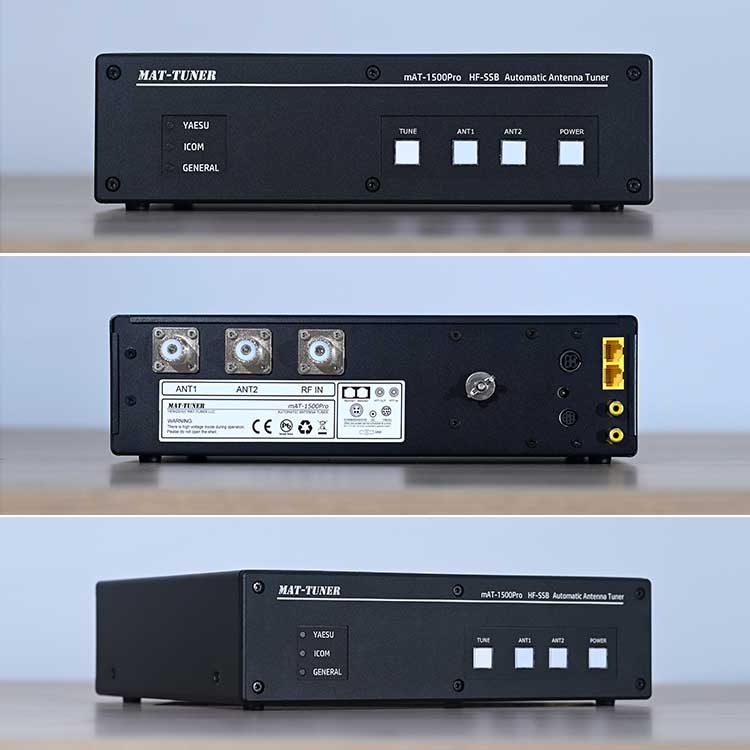

Antenna Tuner is a key device used to solve the impedance mismatch problem between the antenna system and the transmitter/receiver. Its core value lies in acting as a "bridge" to ensure that the radio signal can be transmitted efficiently. Its characteristics and applications are as follows.

Impedance matching: The main function is to convert the input impedance of the antenna (often changing with frequency and environment) to the ideal impedance required by the transmitter (usually 50 ohms pure resistance). By adjusting the internal inductor (L) and capacitor (C) network, the system's standing wave ratio (SWR) is reduced, signal reflection is greatly reduced, and energy transmission efficiency is improved.
Extended working frequency band: For antennas with short electrical length or covering multiple frequency bands (such as vehicle-mounted whip and portable antennas), their natural resonance points are limited. Antenna tuners can make them work efficiently at these non-resonant frequencies, significantly widening the available frequency range.
Protect equipment: High standing wave ratio will cause a large amount of signal to be reflected back to the transmitter's final power amplifier tube, resulting in the risk of overheating or even burning. Antenna tuners effectively protect expensive transmitting equipment by optimizing matching.
Flexibility and adaptability: Especially in mobile or field operations (such as emergency communications, scientific research), it is difficult to set up an ideal size antenna. Antenna tuners allow the use of non-standard sizes or temporary simple antennas (such as long wires, random wires) to overcome site limitations.
Compensation for environmental impacts: The movement of objects near the antenna (such as vehicles, trees), weather changes (such as ice and snow cover) and even conductor corrosion may change the antenna impedance. The antenna tuner can be adjusted dynamically or manually to compensate for these changes.
Shortwave communication: This is the most classic application area of Antenna Tuner. Shortwave broadcasting, ocean-going ship communications, aviation communications and amateur radio rely on ionospheric reflection for long-distance transmission. Antenna tuners enable relatively compact ship-borne, vehicle-borne or base station antennas to work flexibly in multiple bands and adapt to real-time changes in the ionosphere.
Mobile and portable radios: The antennas used in vehicle-mounted radios, backpack radios, field stations, etc. are limited in size and difficult to achieve multi-band resonance. Built-in or external antenna tuners are standard solutions to solve the problems of narrow frequency bands and low efficiency, ensuring smooth communication on the move.
Amateur Radio: Enthusiasts often need to install antennas in limited spaces or experiment with various antenna forms (GP, inverted V, long wire, etc.). Antenna tuners are essential tools for operating multiple bands, using non-resonant antennas or working at non-designed frequencies, greatly increasing the flexibility of communication.
Emergency Communications and Military Communications: Rapid deployment is key at disaster sites or in combat environments. Antenna tuners allow the use of any available conductors (such as wires, metal poles) or even damaged antennas as temporary radiators to ensure communication is established.
Antenna Testing and R&D: When engineers test antenna prototypes or systems, antenna tuners can quickly compensate for impedance mismatches, facilitate direct measurement of antenna radiation characteristics or system performance, and accelerate the R&D process.
Important Note: Antenna Tuner itself does not amplify the signal or improve the radiation efficiency of the antenna itself. Its core contribution is to reduce power loss on the transmission line and "push" as much transmitter power as possible into the antenna. Modern antenna tuners are often integrated with automatic control systems (automatic antenna tuners) to quickly complete matching. Pay attention to safety (high-voltage radio frequency) during operation, and only transmit at high power after successful matching.